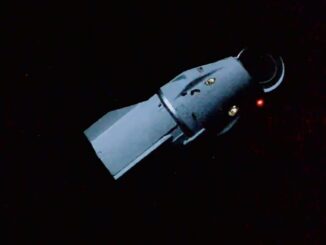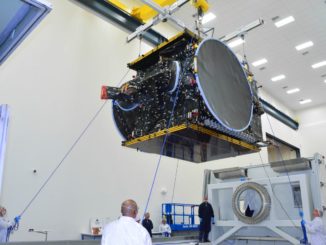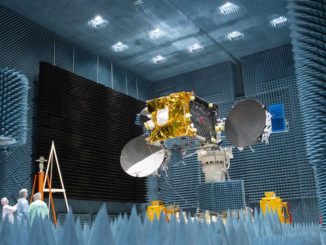Two months after it flew into space and landed smoothly, Blue Origin’s suborbital New Shepard booster made the trip again Friday, proving it can be reused for future space tourism jaunts and laying the groundwork for a future commercial satellite launcher, the company said.
The hydrogen-fueled single stage rocket took off and landed at a West Texas test facility owned by Amazon.com’s Jeff Bezos, who founded Blue Origin in 2000.
Blue Origin said the rocket reached a peak altitude of 333,582 feet, or 101.7 kilometers, on its short up-and-down test flight. The company did not release the duration of Friday’s flight, but a launch following a similar profile Nov. 23 lasted about 11 minutes.
The rocket carried an unoccupied crew capsule, which separated from the New Shepard after its hydrogen-burning BE-3 engine switched off. The crew capsule — a testbed for Blue Origin’s future space tourism ambitions — parachuted to a landing in the West Texas desert.
While the New Shepard did not attain the speed required to reach Earth orbit, it did pass the internationally-recognized boundary of space of about 62 miles, or 100 kilometers.
The Nov. 23 flight made history, with the New Shepard completing the first vertical rocket-assisted landing of a vehicle that flew into space.
Bezos wrote on the company’s website that engineers replaced a few components on the vehicle since November, such as the crew capsule’s parachutes and the rocket’s pyro igniters.
“Data from the November mission matched our preflight predictions closely, which made preparations for today’s re-flight relatively straightforward,” Bezos wrote.
Engineers also made several software improvements, including a change directing the rocket to touch down on its landing pad differently. The New Shepard’s old software told the rocket to land at the center of the circular concrete touchdown zone, while the updated logic allows the booster to come down where it wants, based on the vehicle’s attitude and position.

“It’s like a pilot lining up a plane with the centerline of the runway,” Bezos wrote. “If the plane is a few feet off center as you get close, you don’t swerve at the last minute to ensure hitting the exact mid-point. You just land a few feet left or right of the centerline.”
Bezos said the software update increases margins and makes the rocket landings more resilient to low-altitude winds.
Blue Origin’s experiments with vertical takeoff and landing have occurred at the same time SpaceX made significant strides in its effort to develop the Falcon 9 rocket’s first stage into a reusable booster.
Founded and led by tech billionaire Elon Musk, SpaceX recovered the first stage of a Falcon 9 rocket after a liftoff from Cape Canaveral on Dec. 21. The 156-foot-tall booster returned to a landing pad near the launch site on Florida’s Space Coast, igniting its engines for a series of guidance and braking maneuvers to steer the rocket to a soft touchdown.
SpaceX broadcast video of the landing live, and the Falcon 9’s first stage is bigger and more powerful than Blue Origin’s New Shepard rocket. The rocket landing also occurred after an operational launch carrying 11 Orbcomm communications satellites, which the Falcon 9’s upper stage successfully delivered to orbit at about the same time the booster landed.
Friday’s test, which Blue Origin only announced after its completion, made the New Shepard the first commercial rocket to blast off from the ground under its own power, fly into space and return to Earth intact, then launch again.
The privately-developed SpaceShipOne rocket plane achieved a similar feat in 2004, but an aircraft carried the spacecraft aloft before it fired into space and returned to a runway landing.
Bezos, like Musk, favors vertical landings, not the gliding landings demonstrated by the space shuttle and SpaceShipTwo.
“Though wings and parachutes have their adherents and their advantages, I’m a huge fan of rocket-powered vertical landing,” Bezos wrote on Blue Origin’s website. “Why? Because — to achieve our vision of millions of people living and working in space — we will need to build very large rocket boosters. And the vertical landing architecture scales extraordinarily well.
“When you do a vertical landing, you’re solving the classic inverted pendulum problem, and the inverted pendulum problem gets a bit easier as the pendulum gets a bit bigger. Try balancing a pencil on the tip of your finger. Now try it with a broomstick. The broomstick is simpler because its greater moment of inertia makes it easier to balance.”
Bezos said Blue Origin plans future rockets to haul satellites into orbit, and they will be much bigger than the New Shepard, which engineers sized to launch, tourists, researchers and experiments to the edge of space.
Blue Origin’s first orbital vehicle will consist of two stages and will take off from Cape Canaveral’s Complex 36 launch pad before 2020, the company says. More details on the orbital launcher are due to be released this year.
“We solved the inverted pendulum problem on New Shepard with an engine that dynamically gimbals to balance the vehicle as it descends,” Bezos wrote. “And since New Shepard is the smallest booster we will ever build, this carefully choreographed dance atop our plume will just get easier from here.”
Email the author.
Follow Stephen Clark on Twitter: @StephenClark1.



